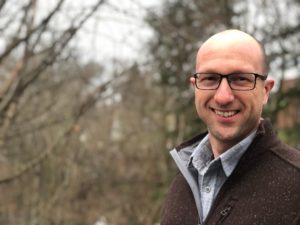Allegheny College has received a two-year, $100,000 grant to help train Allegheny students in laboratory research that will explore whether a minimal form of life can be created beyond the confines of DNA, the central building block for all life on Earth.
Funding for the research project, titled “Toward Creating Alien Life: A Genetic Self-Replicating System Using Chalcogen Bonds,” was provided by the Charles E. Kaufman Foundation of The Pittsburgh Foundation. The grant will help pay for salaries, equipment and supplies, and conference travel starting in the summer of 2021. Associate Professor of Chemistry Mark Ams is the principal investigator for the project.

While the project’s title sounds rather unconventional, the project has serious scientific goals.
“Alien life sounds pretty exotic and dramatic,” said Ams. “I place high emphasis on the word ‘toward,’ though, that comes before alien life in the title of the proposal. The main ‘product’ will be the high-quality laboratory training of undergraduate students in chemistry research at Allegheny, in addition to the experiences they will gain by interacting at professional conferences. This will happen throughout the summer months and academic year as students join the lab and start their projects.”
All of the project’s experiments will be conducted by Allegheny students under the close mentorship of Ams. In terms of a final scientific product, Ams said that the goal is to publish the results. The grant covers two years, which will be spent primarily on conducting laboratory experiments. “If the research goes smoothly, a publication will follow,” he said.
At the heart of this project is the fundamental question of whether life can exist without DNA — “the only blueprint for life humans know,” Ams explained. “However, the invention of an alternative chemical template to DNA, one that is radically different and not based on biotic building blocks (i.e., exobiotic), would represent a seismic shift of our own understanding of DNA’s uniqueness and origins, as well as open the door for potentially new advances in biotechnology.”
The research outline proposes an alternative chemical architecture to DNA, using chalcogen atoms as part of a new chemical template. The goal is to determine whether the proposed template can carry out the two basic functions of self-replication as well as carry a genetic code, a combination that is unprecedented in current exobiotic designs. Unlike DNA, the proposed minimal design does not require help from enzymes to operate, and thus is engineered to function in the early stages of its evolutionary development.
To achieve the research goal, Ams and the student researchers plan to demonstrate the “proof-of-concept” that the chalcogen template can undergo autocatalytic self-replication. Thus, the “big picture” of this proposal is to stimulate open-ended evolution at the molecular level, moving researchers a step closer to realizing a synthetic cell of alien origins.
“As a long-term consequence, that would be an exciting breakthrough and could have many implications for our fundamental understanding of the origins of life on Earth,” said Ams, who has been a professor at Allegheny since 2009. “On the technological advancement side, there may also be many benefits to having an alternative life form available to humankind. Its success at mimicking DNA’s core roles of replication and information storage, yet without enzymatic help, has direct implications for molecular computing and sensor technologies, as well as expanding our conception of life beyond DNA or even biotic chemicals.”
He added that other long-term benefits include a potential new source of natural products, therapeutics and synthetic reagents.
“The goal is to find a pathway toward life that uses new chemicals in solution, much like our biology works, but without anything DNA- or even biotic-based. The eventual creation of alien life that is only cellular in size or intelligence is a monumental achievement. It does not need to be intelligent or high functioning in order to demonstrate the fundamental proof-of-principle that life may be possible without DNA,” Ams said.
As an interesting aside, Ams notes that several current space initiatives have been inspirations for this project. “For instance, NASA has made groundbreaking discoveries in recent years on the moons Europa (Jupiter), Enceladus and Titan (Saturn), showing that they contain complex carbon molecules as well as liquid oceans of water or methane in which to dissolve them,” he said.
Ams also points to the 2024 Europa Clipper mission, a $4.25 billion NASA project that will send a spacecraft to orbit Europa for the primary purpose of determining its viability for harboring life, whether DNA-based or otherwise. “And collaborations with companies such as SpaceX are making human space travel much more feasible, as seen by the exciting rocket launches and landings this year,” he said.